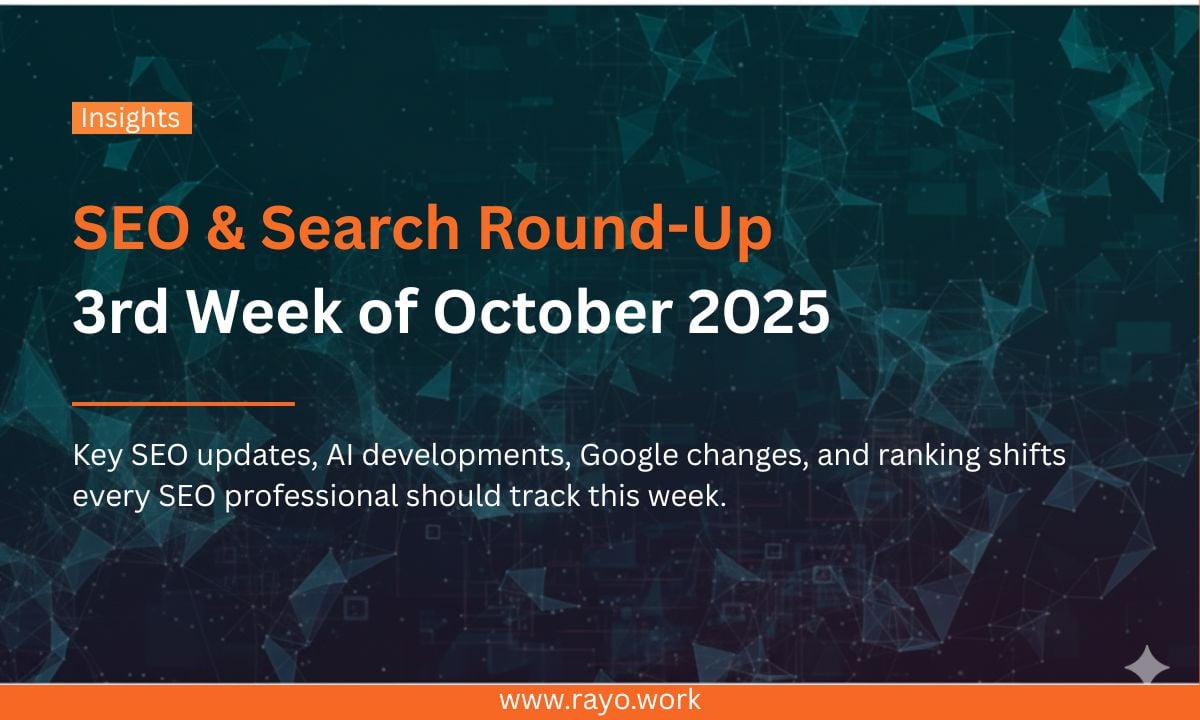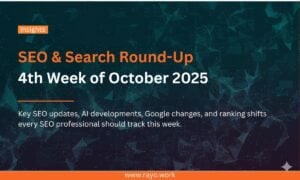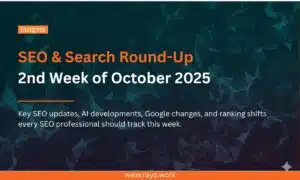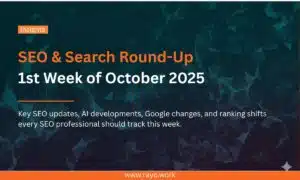The third week of October proved that search continues to reinvent itself. From Google’s growing AI integration and the rollout of personalised AI Mode experiences to early experiments with ads inside AI results, every update reflected how search is becoming more adaptive, predictive, and commercially driven.
Add to that the strange mismatch between GA4 and Search Console reporting, breakthroughs in voice retrieval models, and Google’s entry into generative image creation with Nano Banana, and it’s clear we’re entering a new phase of search where analytics, creativity, and automation converge.
Below are the biggest developments from this week, and what they mean for your strategy.
1. Google AI Mode Now Personalises Results Based on Your Activity
What happened:
Google’s AI Mode now displays a “Based on your Google activity” disclaimer for signed-in users. The feature draws on your search and conversation history to personalise suggestions and context, meaning results adapt to individual patterns.
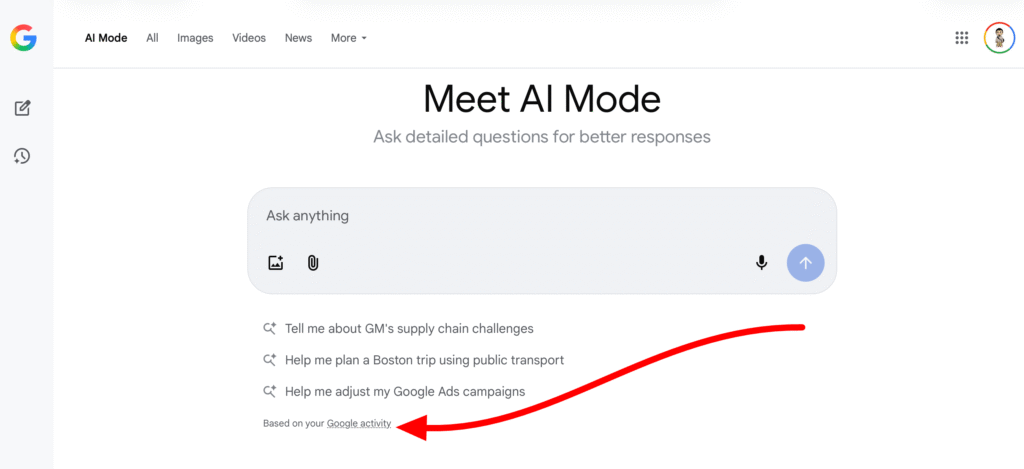
Forum discussion at X.
🆕 AI Mode page default suggestions 'Based on your Google activity' pic.twitter.com/WGYhDbYxh5
— Gagan Ghotra (@gaganghotra_) September 30, 2025
Why it matters:
This confirms that Google’s AI Mode uses behavioural data to tailor results, signalling a move toward deeply personalised search experiences.
What to do:
- Test logged-in vs. logged-out results for keyword tracking.
- Focus on contextual consistency and trustworthy signals for returning users.
- Optimise for broad intent coverage, not just keyword match.
2. Google Ads Coming to AI Mode (Tests in EU & US)
What happened:
Google is testing search ads inside AI Mode, integrating them within conversational answers. The rollout began in the U.S. and Europe. Ads are visibly labelled, but naturally embedded within AI responses.
Frederik posted this on LinkedIn
Why it matters:
This blurs the line between organic and paid visibility. SEOs will need to monitor how ad presence affects user interaction and click distribution.
What to do:
- Track CTR changes as AI Mode ads expand.
- Optimise messaging for conversational ad formats.
- Combine paid and organic strategies for shared queries.
3. GA4 Shows Organic Traffic Surge While Search Console Data Stays Flat
What happened:
SEOs are reporting spikes in GA4’s “organic traffic” metrics not reflected in Search Console data. Google clarified that the discrepancy is due to differences in how GA4 attributes sessions, not a bug. This is also reported on SERoundable.
Dana DiTomaso posted a video on this:
Why it matters:
GA4 attributes traffic differently (based on sessions and medium), while Search Console logs only verified search clicks. Over-reliance on GA4 may distort SEO performance reporting.
What to do:
- Use Search Console as your primary SEO reference.
- Re-align dashboards to reflect cross-source consistency.
- Add explanatory notes for clients when reporting traffic fluctuations.
4. Google Voice Search Evolves to “Speech-to-Retrieval”
What happened:
Google unveiled a new speech-to-retrieval model for Voice Search. Instead of converting speech to text and then running a search, it directly retrieves relevant information, making voice responses faster and more accurate.
Gagan Posted on it:
🆕 Huge update for Voice Search -> now its powered by Speech-to-Retrieval engine and this new process don't convert speech to a text transcript & then do a web search rather this new technique uses an audio encoder for converting sound into audio embeddings which then is used to… https://t.co/iv2q4Kp0Qt pic.twitter.com/bCGwIfKNEh
— Gagan Ghotra (@gaganghotra_) October 8, 2025
Why it matters:
This upgrade moves voice search closer to semantic understanding. It’s a clear sign that natural, conversational phrasing is key to ranking in voice results.
What to do:
- Optimise for question-style queries (“How do I…”, “Where can I…”).
- Strengthen FAQ sections with complete, natural answers.
- Target mobile-first indexing for voice accessibility.
5. Nano Banana: Google’s AI Image Generator Lands in Search & NotebookLM
What happened:
Google’s new Nano Banana (Gemini’s lightweight AI image model) has officially rolled out to Search and NotebookLM, with integration into Photos on the way. It allows users to generate and edit visuals directly within the search interface.

Why it matters:
This transforms search into a creative space. It’s another sign of generative search merging with visual content, creating opportunities for brands with image-rich strategies.
What to do:
- Optimise all visuals with rich metadata and descriptive captions.
- Explore generative AI features for branded creative assets.
- Monitor how AI-generated visuals appear in your niche queries.
Other Great Search Threads
- Anthony Higman on Google Ads “People Also Consider” Badge
→ Anthony noticed unusual ad behavior where “People Also Consider” badges appeared on searches for his branded terms. (X post) - Glenn Gabe Flags New Ranking Patterns
→ Glenn spotted early signs of ranking behavior shifts tied to AI and algorithmic interaction, noting unusual “jumps and rebalances.” (X post) - YouTubeInsider on Visual Search Moves
→ YouTube is testing new visual search capabilities that tie into both products and topics, signaling a shift toward image-based discovery. (X post) - Gagan Ghotra on Google AI Agent / Gemini Plans
→ Gagan shared insights that Google is preparing to launch an AI Agent system within Gemini, enabling contextual and task-oriented agents across Google’s ecosystem. (LinkedIn post) - John Mueller on Web Indexing & Canonical Behavior
→ On Bluesky, John clarified Google’s approach to canonical signals in edge cases, especially when alternate tags are imperfect. (Bluesky post)

Ridam Khare is an SEO strategist with 7+ years of experience specializing in AI-driven content creation. He helps businesses scale high-quality blogs that rank, engage, and convert.
